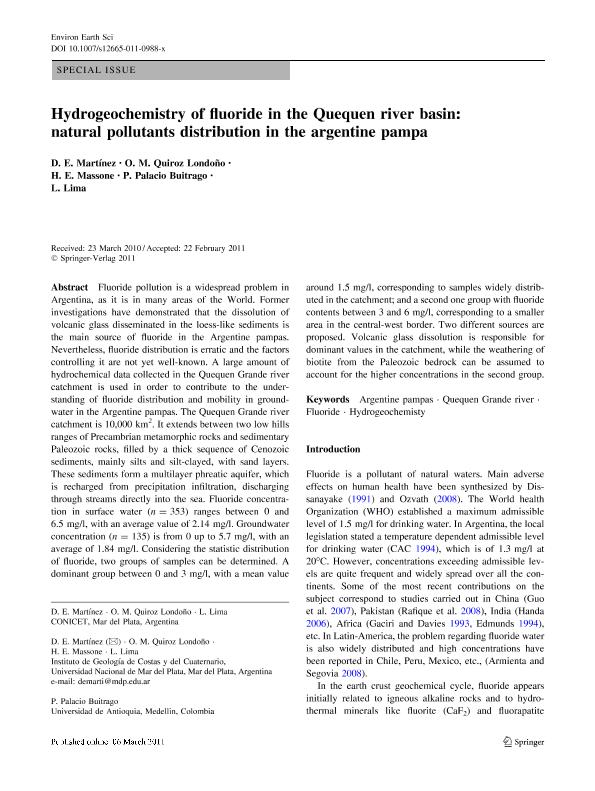Mostrar el registro sencillo del ítem
dc.contributor.author
Martínez, D. E.
dc.contributor.author
Quiroz Londoño, Orlando Mauricio

dc.contributor.author
Massone, Hector Enrique

dc.contributor.author
Palacio Buitrago, P.
dc.contributor.author
Lima, María Lourdes

dc.date.available
2023-06-05T13:03:31Z
dc.date.issued
2012-01
dc.identifier.citation
Martínez, D. E.; Quiroz Londoño, Orlando Mauricio; Massone, Hector Enrique; Palacio Buitrago, P.; Lima, María Lourdes; Hydrogeochemistry of fluoride in the Quequen river basin: Natural pollutants distribution in the argentine pampa; Springer; Environmental Earth Sciences; 65; 2; 1-2012; 411-420
dc.identifier.issn
1866-6299
dc.identifier.uri
http://hdl.handle.net/11336/199503
dc.description.abstract
Fluoride pollution is a widespread problem in Argentina, as it is in many areas of the World. Former investigations have demonstrated that the dissolution of volcanic glass disseminated in the loess-like sediments is the main source of fluoride in the Argentine pampas. Nevertheless, fluoride distribution is erratic and the factors controlling it are not yet well-known. A large amount of hydrochemical data collected in the Quequen Grande river catchment is used in order to contribute to the understanding of fluoride distribution and mobility in groundwater in the Argentine pampas. The Quequen Grande river catchment is 10,000 km2. It extends between two low hills ranges of Precambrian metamorphic rocks and sedimentary Paleozoic rocks, filled by a thick sequence of Cenozoic sediments, mainly silts and silt-clayed, with sand layers. These sediments form a multilayer phreatic aquifer, which is recharged from precipitation infiltration, discharging through streams directly into the sea. Fluoride concentration in surface water (n = 353) ranges between 0 and 6.5 mg/l, with an average value of 2.14 mg/l. Groundwater concentration (n = 135) is from 0 up to 5.7 mg/l, with an average of 1.84 mg/l. Considering the statistic distribution of fluoride, two groups of samples can be determined. A dominant group between 0 and 3 mg/l, with a mean value around 1.5 mg/l, corresponding to samples widely distributed in the catchment; and a second one group with fluoride contents between 3 and 6 mg/l, corresponding to a smaller area in the central-west border. Two different sources are proposed. Volcanic glass dissolution is responsible for dominant values in the catchment, while the weathering of biotite from the Paleozoic bedrock can be assumed to account for the higher concentrations in the second group.
dc.format
application/pdf
dc.language.iso
eng
dc.publisher
Springer

dc.rights
info:eu-repo/semantics/openAccess
dc.rights.uri
https://creativecommons.org/licenses/by-nc-sa/2.5/ar/
dc.subject
ARGENTINE PAMPAS
dc.subject
FLUORIDE
dc.subject
HYDROGEOCHEMISTY
dc.subject
QUEQUEN GRANDE RIVER
dc.subject.classification
Oceanografía, Hidrología, Recursos Hídricos

dc.subject.classification
Ciencias de la Tierra y relacionadas con el Medio Ambiente

dc.subject.classification
CIENCIAS NATURALES Y EXACTAS

dc.title
Hydrogeochemistry of fluoride in the Quequen river basin: Natural pollutants distribution in the argentine pampa
dc.type
info:eu-repo/semantics/article
dc.type
info:ar-repo/semantics/artículo
dc.type
info:eu-repo/semantics/publishedVersion
dc.date.updated
2023-06-05T11:58:33Z
dc.journal.volume
65
dc.journal.number
2
dc.journal.pagination
411-420
dc.journal.pais
Alemania

dc.description.fil
Fil: Martínez, D. E.. Universidad Nacional de Mar del Plata. Facultad de Ciencias Exactas y Naturales. Instituto de Geología de Costas y del Cuaternario. Provincia de Buenos Aires. Gobernación. Comisión de Investigaciones Científicas. Instituto de Geología de Costas y del Cuaternario; Argentina
dc.description.fil
Fil: Quiroz Londoño, Orlando Mauricio. Universidad Nacional de Mar del Plata. Facultad de Ciencias Exactas y Naturales. Instituto de Geología de Costas y del Cuaternario. Provincia de Buenos Aires. Gobernación. Comisión de Investigaciones Científicas. Instituto de Geología de Costas y del Cuaternario; Argentina
dc.description.fil
Fil: Massone, Hector Enrique. Universidad Nacional de Mar del Plata. Facultad de Ciencias Exactas y Naturales. Instituto de Geología de Costas y del Cuaternario. Provincia de Buenos Aires. Gobernación. Comisión de Investigaciones Científicas. Instituto de Geología de Costas y del Cuaternario; Argentina
dc.description.fil
Fil: Palacio Buitrago, P.. Universidad de Antioquia; Colombia
dc.description.fil
Fil: Lima, María Lourdes. Universidad Nacional de Mar del Plata. Facultad de Ciencias Exactas y Naturales. Instituto de Geología de Costas y del Cuaternario. Provincia de Buenos Aires. Gobernación. Comisión de Investigaciones Científicas. Instituto de Geología de Costas y del Cuaternario; Argentina
dc.journal.title
Environmental Earth Sciences
dc.relation.alternativeid
info:eu-repo/semantics/altIdentifier/url/https://link.springer.com/article/10.1007/s12665-011-0988-x
dc.relation.alternativeid
info:eu-repo/semantics/altIdentifier/doi/http://dx.doi.org/10.1007/s12665-011-0988-x
Archivos asociados
